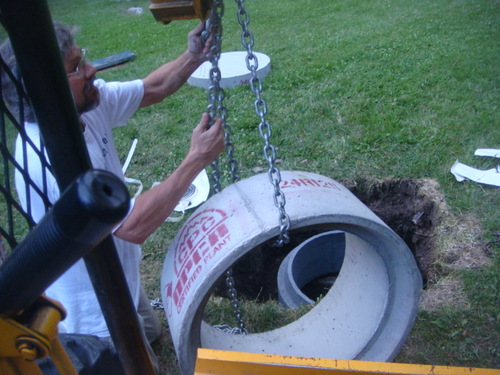Yesterday we decided to finish off our septic tank project. Several weeks ago we found a tank pumper who could locate the tank for us. The thing about these tanks is they are buried a couple of feet underground, so it's a guessing game where the access port is. One locating technique is to use steel rods to probe in the ground, but we have a lot of rocks here, so there are a lot of false positives.
To give you an idea of the challenge, when we looked for the tank at our house a couple of years ago, we had photographs of it being installed, but it still took Mr. Troutbend 12 hours to find it. In the process he strained his bowling arm, which he is usually very careful to avoid, but happily it improved his bowling, and he bowled a perfect game soon thereafter.
The tank we worked on this summer was installed more than 45 years ago, and there are no pictures or clues as to where it is. But this professional man found it within a couple of minutes. He and his wife dug down to the access port, leaving a hole in the yard 2 feet deep, and 36 inches across.
To save digging next time we need to get to the tank, we decided to install concrete risers that would bring the cover to grade level. Each riser is 24 inches across and 12 inches tall; each one weighs about 300 pounds. The lid is 3 or 4 inches thick, 24 inches around, and also very heavy.
Murphy's Law kicked in when we went to pick up all this concrete the tailgate on the pickup wouldn't open up - the handle had broken somewhere on the inside. Not a problem loading up - the forklift was able to lift everything into the truck bed. But we were worried about unloading once we got home.
But I googled it first chance I got, and found an excellent video about replacing that handle. The most important thing we needed to know was how to remove the bezel from around the handle - it snaps off. We thought we were going to have to scrape away the Rhino liner (sprayed in rubber stuff) to get at the bolts, so thank goodness we didn't have to. Really, the Internet is the best thing about being alive today.
We used our skid steer (generic name for a Bobcat loader) to move the concrete around. I drove, and we used large chains to lower the heavy pieces into the hole and get them centered. There was a lot of trial and error. Fortunately, Mr. Tbend is a wonderful, patient man who stubbornly persists until the goal is reached. Fortunately, I know how to drive heavy equipment without conking him on the head, running over his foot, or breaking the concrete.
This single chain arrangement wasn't going to work, but we didn't know it at the time:

The two chain method worked, but it took some arranging to get it right. He is applying that black rubber stuff to the bottom of the riser to form a seal.

Originally he told me we were just going to do a practice run, but it turned into the whole project.
We thought that once we had the bottom piece placed the top one would be easy to tip on there, but again, the one chain method didn't work.

The problem with all these chains is getting them out from under the edge of each 300 pound piece of concrete without dropping them into the open septic tank (we'd removed the original cover in order to replace it with a new one on top of the risers) or falling in. There were times I couldn't bear to watch, so I just covered my eyes.
We finally got it done, all fingers and toes intact. I didn't get around to getting a picture of the finished product. I asked Mr. YouKnow if he was sorry we didn't hire someone to do it, and he said "nope."


